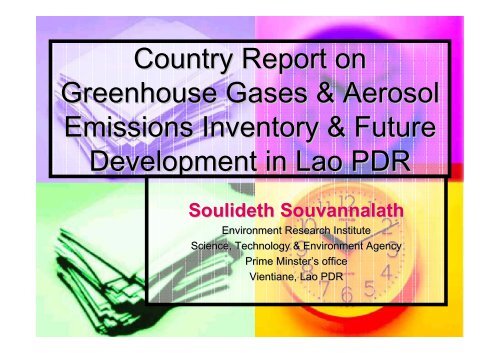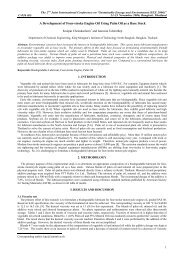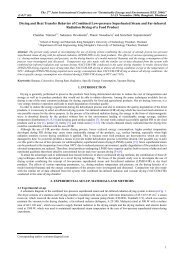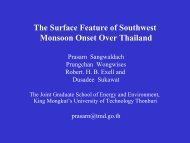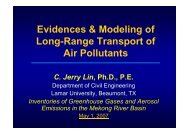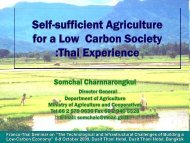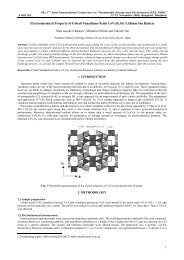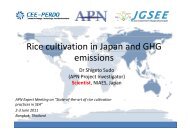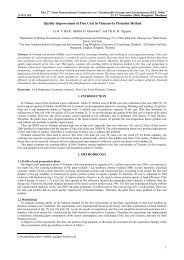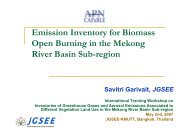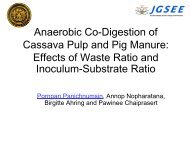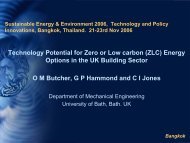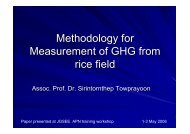Mr. Soulideth Kathiya
Mr. Soulideth Kathiya
Mr. Soulideth Kathiya
You also want an ePaper? Increase the reach of your titles
YUMPU automatically turns print PDFs into web optimized ePapers that Google loves.
Country Report on<br />
Greenhouse Gases & Aerosol<br />
Emissions Inventory & Future<br />
Development in Lao PDR<br />
<strong>Soulideth</strong> Souvannalath<br />
Environment Research Institute<br />
Science, Technology & Environment Agency<br />
Prime Minster’s s office<br />
Vientiane, Lao PDR
I. Introduction<br />
• The economic development in the Lao<br />
PDR is mostly relied on utilizing the natural<br />
resources<br />
• The Government has implemented the<br />
innovative guideline in an attempt to<br />
gradually increase the ratio of highly<br />
economic growth since 1996.<br />
• the stronger enhancement of the<br />
environmental protection and improvement<br />
policy on a number of the economic<br />
sectors to which it has been legislated for<br />
the purpose of achieving the socio-<br />
economic development
II. The Greenhouse<br />
Inventory for Lao PDR<br />
• The assessment of the greenhouse<br />
gases based on the volume of tasks,<br />
• The total multiplier used in this<br />
inventory was utilizing the absolute<br />
value of the IPCC<br />
• The results, the emissions of the GHG<br />
of the various sectors as the indicated<br />
in table:
Sectors<br />
CO 2<br />
CH 4<br />
CO<br />
N 2 O<br />
NO x<br />
Energy Sector<br />
Fossil Fuel Consumption<br />
414.9<br />
Traditional biomass burned for energy<br />
22.7 5<br />
157. 92<br />
0.12<br />
4.18<br />
Agriculture Sector<br />
Enteric fermentation<br />
97.92<br />
Manure management<br />
14.38<br />
Rice cultivation<br />
158.97<br />
Forestry Sector<br />
Change in forest and woody biomass<br />
-121,614.00<br />
29.5<br />
257.8<br />
0.2<br />
7.3<br />
Forest conversion: Aboveground CO 2<br />
released from on site burning<br />
6,752.67<br />
Forest conversion: Aboveground CO2<br />
released from off site burning<br />
628.16<br />
Aboveground CO 2 released from<br />
decay<br />
9,247.84<br />
Waste<br />
Landfills<br />
11.2<br />
Waste water<br />
0.23<br />
Grand Total:<br />
-104,570<br />
312<br />
258<br />
0<br />
7<br />
Source: Science Technology & Environment Agency, 2000 (STEA)<br />
* 1Gg = 109 g
III. Technology Needs and<br />
Priorities for Mitigating GHG<br />
Emission in Lao PDR.
Hydro Energy:<br />
• The annually average flowing water<br />
amount accounts: 8,500 cubic matres/<br />
• Contribute to the Mekong River’s: 35%,<br />
including rainy season is the amount of<br />
following water up to 80% and in dry<br />
season up to approximately 20% of the<br />
annually total amount of flowing water.<br />
• The water utilization is mainly in the<br />
agriculture sector; for example, irrigation,<br />
fishery, cultivation, and animal husbandry.<br />
• Apart from that, water is still used in the<br />
electric hydropower development that<br />
potentially possesses approximately<br />
23,000 megawatts, within which less than<br />
5% of the total potential gas been used.
Forestry:<br />
• Forest cover: 41% or 11.2 million hectares<br />
• In Lao PDR, there are 20 national<br />
Biodiversity Conservation Areas,<br />
• The forest resources have played the<br />
important roles in accumulating the<br />
national incomes, been the foodstuff and<br />
the additionally rural grass root people’s<br />
incomes.<br />
• Fire wood is the people’s s main energy.<br />
• About 85% have been used for household<br />
consumption.<br />
• The average of fire wood utilization is about 0.75<br />
- 2.92 m3 or 0.58 - 2.26 T/ Pers / year
Minerals:<br />
• The Lao PDR has variety of valuable mineral<br />
potentials, which those minerals have only been<br />
mined in a small scale.<br />
• It has a large number of various types’ coal<br />
deposits, which can be used, in the field of energy<br />
resources.<br />
• Anthracite and lignite have been utilized in the<br />
manufacturing industry.<br />
• Only a small amount of coal, which has been used<br />
as fuel energy for the people’s s handicraft of brick<br />
burning process.<br />
• Hydropower<br />
• The flowing river electric hydropower<br />
• The solar photovoltaic energy production<br />
• The biomass gasified electricity power
IV. Technological Options<br />
and Reduction of<br />
Greenhouse Gas Emissions<br />
in Lao PDR.
The Transportation Field<br />
• Vehicle in the Lao PDR are composed of different<br />
types and brands with which its growth rate as<br />
rapidly increased annually; especially, motorcycles.<br />
• The major of vehicles belong to private ownership<br />
and a large number of used vehicles imported from<br />
abroad.<br />
• These vehicles do not only consume diesel, but also<br />
use a great deal of petrol.<br />
• Therefore, those vehicles are considered the main<br />
cause of increasingly air pollution problems in big<br />
towns and cities nowadays.<br />
• The scientific research and comparison of<br />
exhausted gas emission ranging from CO2, CO,<br />
NOx and other gases from a large number of<br />
different vehicles in the transportation system can<br />
be notice that, for example the usage of the mass or<br />
public transportation in big cities is the best choice.
Agriculture Field:<br />
• The Breeding of<br />
Masticating<br />
Animals<br />
• The Wet<br />
Plantation<br />
• The Use of<br />
Natural<br />
Fertilizers<br />
(Manure or<br />
Vegetable<br />
Waste matters)<br />
The Original<br />
Source of CH4<br />
in Agriculture<br />
Field<br />
Masticating<br />
Animals<br />
Wet Rice<br />
Plantation<br />
Use Natural<br />
Fertilizers<br />
The Reduction<br />
methods<br />
Improve animal feeds<br />
through additional animal<br />
feed strategies<br />
Soil drying techniques<br />
- Use biogas digester with<br />
a small scale cooking<br />
stove (8-16 m3)<br />
- Use biogas digester with<br />
a large scale cooking<br />
stove (>30 m3)
Forestry Field:<br />
• The conservation areas construction<br />
• The permanent cessation of slash -<br />
and - burn shifting cultivation<br />
method<br />
• The forest administration<br />
management<br />
• The forest rehabilitation<br />
• The villagers’ forest management
Toxic Waste Field:<br />
• Waste water & polluted water from industry &<br />
handicraft<br />
• Use of the fairly out-of<br />
of-date technology,<br />
which modernized advanced countries have<br />
not allowed using any longer, and constituted<br />
less than 70%<br />
• Caused by the use of fuel into the stream<br />
boiler such as, firewood, sawdust & wood<br />
shavings, diesel & bunker/ fuel oil, and coal<br />
• Caused by the use of chemical substances<br />
into the process of production<br />
• Caused by inappropriately eliminating<br />
practice of the waste material from factories<br />
themselves
V. Conclusion<br />
• The socio-economic development must be<br />
implemented<br />
• The utilization of advanced technology is<br />
considered which needs to be developed<br />
& resolved to suit the real situation of each<br />
field of work<br />
• To make use of all existing technocrats’<br />
competency so as to systematically train<br />
them in the environmental field of work.<br />
Contribution for National Environmental<br />
Fund


